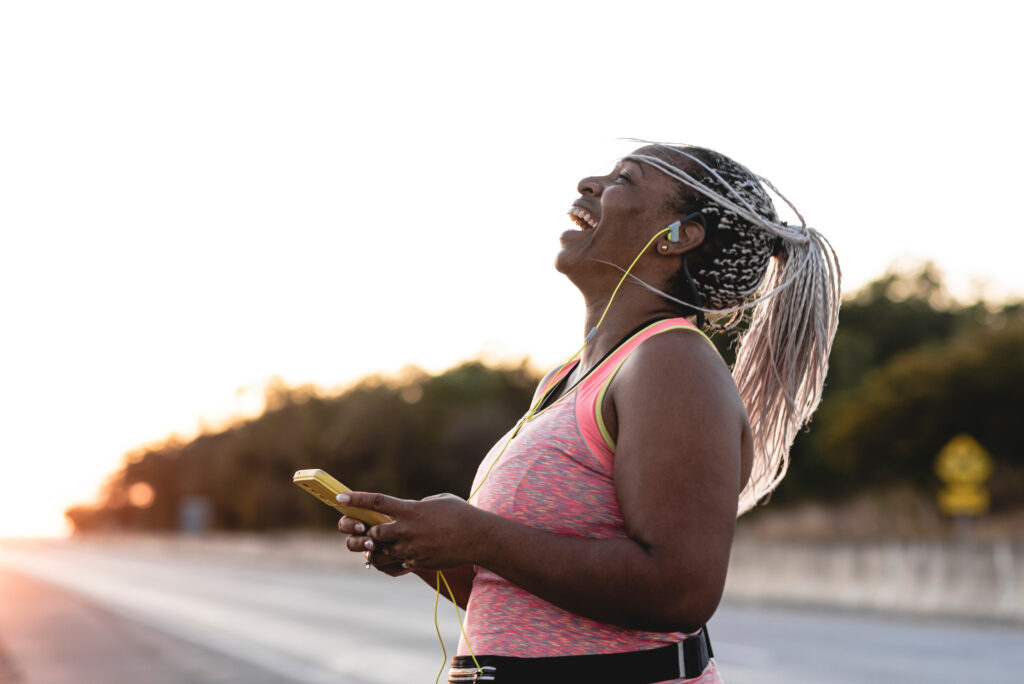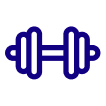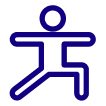Taking care of your physical health is about more than just exercise; it’s about supporting your body, mind and long-term well-being. Staying active doesn’t have to be complicated: small, simple actions, like walking during your lunch break or stretching at home, can add up to big benefits over time.
Find practical ways to fit movement into your life, no matter your schedule or starting point, and build a healthier future one step at a time.
Why physical activity matters.
Moving your body is one of the most important ways to take care of your physical and mental health.
You don’t need a gym membership, fancy workout clothes or expensive equipment to stay active. Instead, make movement part of your daily routine in ways that work for you. For example, 10-minute walks in the morning, after lunch and in the evening add up to a full half-hour of heart-healthy activity.
Regular movement every day can help
- lower stress;
- boost your energy;
- strengthen your body;
- prevent long-term health problems, including heart disease and diabetes.1
Remember, every little bit counts. Small, consistent steps can pave the way to a healthier, happier you.


Keep your body moving.
Staying active is key to feeling your best. To support your health and wellness, aim for 30 minutes of physical activity that gets your heart rate up, like brisk walking or dancing, five days a week. That adds up to two and a half hours of movement every week.2 If you prefer more-intense activities, such as jogging or cycling, aim for 75 minutes per week instead.2
Don’t forget strength-building exercises, like lifting weights or yoga, at least two days a week to keep your muscles strong.2
If you’re not sure where to start, talk to your doctor or a health coach for personalized guidance.
How active are you?†
†Cigna Healthcare is not collecting or using the data entered. This is intended to help provide personalized recommendations.

Make movement part of your routine.
Life is busy. But even on your most hectic days, there are small ways to stay active.

Burn calories dancing.
Try making dance a part of your morning routine or a fun thing you do with family and friends after work. Dancing can burn up to 300 calories in 30 minutes.8

Walk during lunchtime.
Getting up from your workspace and walking for 10 to 30 minutes supports your physical health and could boost your mood and leave you feeling more productive.9

Exercise together.
Working out with someone or taking a class can make it easier to stay active. There are lots of fun ways to stay active together, including home workout videos, community classes, yoga, biking, basketball, cricket, running, boxing and badminton.

Get energized outside.
Vitamin D can help you feel happier and more energetic, and just 10 minutes of exposure helps.10 Walk, run or play sports: there are many fun activities to do outside alone or with your loved ones.

Set a goal for yourself.
A goal can help you stay consistent with your health. Try taking 1,000 or more additional steps per day, adding one more workout to every week, or doing other physical activities you enjoy.

Make time to stretch.
You don’t need to work up a sweat to give your body healthy movement. In fact, stretching for 10 minutes is a great gentle exercise that doesn’t put strain on your joints.11
Select a scenario below to find simple ways to work movement into your routine.
“I’m a parent juggling kids and a busy schedule.”
By keeping up with your kids and tackling household tasks, you’re already on the move. Here are a few ideas to add more movement into your day:
- Take a family walk after dinner to unwind, get some fresh air and move your body.
- Engage in physical activities with your kids, such as playing tag or dancing.
- Set aside a few minutes to exercise when the kids are at practice or at a friend’s house.
“I work full-time and sit at a desk all day.”
You’re doing a lot to stay productive at work. A little movement can help boost your energy and focus even more:
- Set a timer to stand up and stretch every 30 minutes or in-between meetings.
- Take a brisk 5–10 minute walk during lunch or coffee breaks.
- Get creative with your commute: park farther away or get off public transit one stop early.
“I’m a caregiver for an elderly parent or family member.”
Your care and dedication make a huge difference. Here are a few simple ways to focus on your own health while staying by their side:
- Do simple stretches or chair exercises alongside your loved one.
- Take short walks together, if they’re able to join.
- Use moments when they are resting to do quick cardio exercises, such as high knees or jumping jacks.
“I’m balancing work and school.”
Balancing your busy schedule can be a workout in itself. Here are some ways to sneak in extra movement:
- Do 10-minute movement breaks, like yoga or a quick walk, between study sessions.
- Use the time spent watching online lectures or reading to stretch or do light exercises.
- Make walking part of your commute to class or work.
Find free or reduced-cost virtual and in-person exercise classes, community recreation services, wellness programs and more.

Recharge with better sleep.
Sleep helps your body stay strong, heal faster and perform at its best; it’s when your body repairs itself. Getting at least seven hours each night can help you maintain your physical health.
Quality sleep can help you
- stay active and feel more energetic;12
- prevent illness and manage long-term conditions;
- lower your risk of anxiety and depression;13
- decrease blood pressure levels;14
- strengthen your immune system to fight off infections.15
If you’re having trouble sleeping or finding you need support, talk to your doctor or call the number on your Cigna Healthcare® ID card.
Resources and tools
Ready to make the next step in your health journey? Your future needs you, and a healthier tomorrow starts with the actions you take now. Explore these tools to maintain your health, prevent illness and lower health care costs.
Use personalized tools
Access health information anytime, anywhere.
Download the myCigna App:

This information is for educational purposes only. It is not medical advice. Always consult your doctor for appropriate examinations, treatment, testing and care recommendations. Any third-party content is the responsibility of such third party. Cigna Healthcare® does not endorse or guarantee the accuracy of any third-party content and is not responsible for such content. Your access to and use of this content is at your sole risk.
Cigna Healthcare products and services are provided exclusively by or through operating subsidiaries of The Cigna Group.
- Centers for Disease Control and Prevention (CDC). “Benefits of Physical Activity.” April 24, 2024. https://www.cdc.gov/physical-activity-basics/benefits/index.html
- CDC. “Adult Activity: An Overview.” December 20, 2023. https://www.cdc.gov/physical-activity-basics/guidelines/adults.html
- Tresca AJ. “Targeting the Average Number of Steps per Day for Your Age and Sex.” Verywell Health. Last updated July 11, 2024.https://www.verywellhealth.com/average-steps-per-day-8671820
- CDC. “Adult Activity: An Overview.” December 20, 2023. https://www.cdc.gov/physical-activity-basics/guidelines/adults.html
- Brown S. “Moderate Exercise Isn’t Enough to Offset Sitting All Day, Study Says.” Verywell Health. November 16, 2024. https://www.verywellhealth.com/risks-of-sitting-too-long-8744422
- American Heart Association. “Strength and Resistance Training Exercise.” January 19, 2024. https://www.heart.org/en/healthy-living/fitness/fitness-basics/strength-and-resistance-training-exercise
- University of California Davis Health. “How to improve your stretching and flexibility for better health.” October 11, 2024. https://health.ucdavis.edu/blog/cultivating-health/how-to-improve-your-stretching-and-flexibility-for-better-health/2024/10
- Vega A. “21 Secrets from Latin American women to stay healthy and fit.” Healthy Hispanic Living. February 28, 2022. https://healthyhispanicliving.com/fitness/lifestyle/21_secrets_from_latin_american_women_to_stay_healthy_and_fit/
- WebMD. “Exercise and Type 2 Diabetes.” Last reviewed January 25, 2025. https://www.webmd.com/diabetes/exercise-guidelines
- Raman R. “How to Safely Get Vitamin D From Sunlight.” Healthline. Last updated November 26, 2024. https://www.healthline.com/nutrition/vitamin-d-from-sun
- Lindberg S. “Stretching: 9 Benefits, Plus Safety Tips and How to Start.” Healthline. Last updated May 19, 2023. https://www.healthline.com/health/benefits-of-stretching
- CDC. “About Sleep and Your Heart Health.” May 15, 2024. https://www.cdc.gov/heart-disease/about/sleep-and-heart-health.html
- Bruce DF. “Sleep and Depression.” WebMD. Last reviewed September 19, 2024. https://www.webmd.com/depression/depression-sleep-disorder
- Lopez-Jimenez F. “Sleep deprivation: A cause of high blood pressure?” Mayo Clinic. July 9, 2024. https://www.mayoclinic.org/diseases-conditions/high-blood-pressure/expert-answers/sleep-deprivation/faq-20057959
- Yale Medicine. “How Sleep Affects Your Immune System.” March 13, 2023. https://www.yalemedicine.org/news/how-sleep-affects-immunity